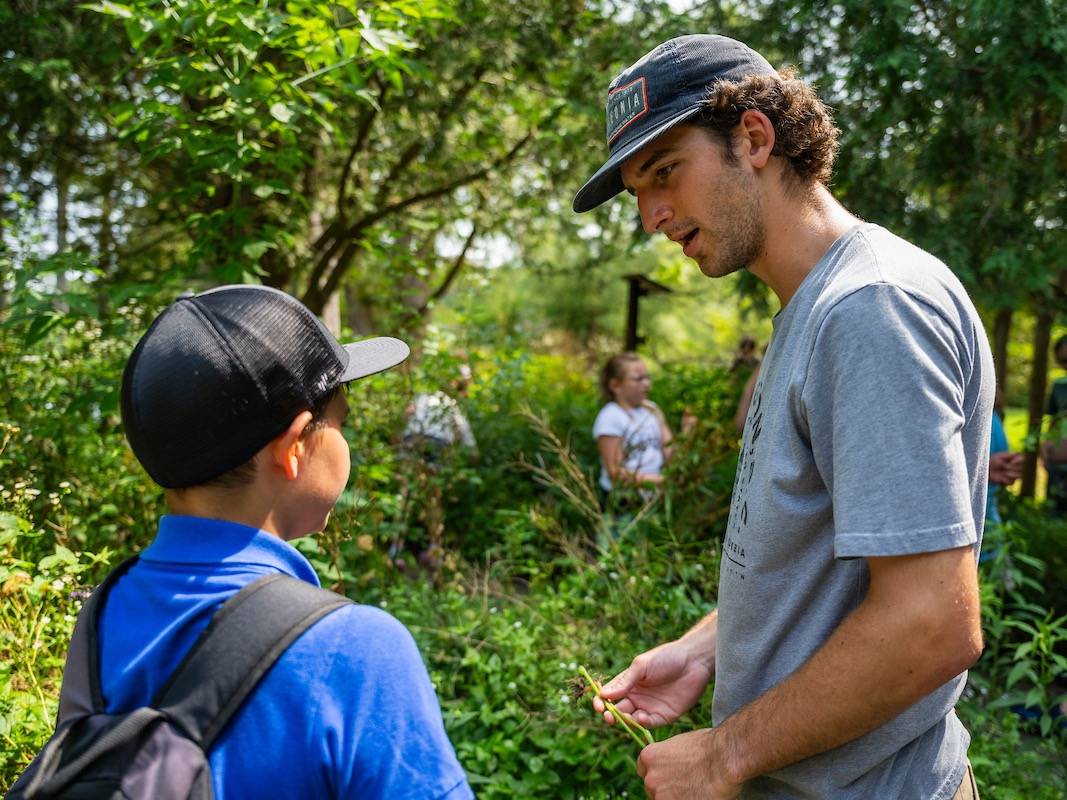Native Bees are still in trouble! A new study from the DEC estimates that of the 457 native bee species that call New York state their home, at least 23% of these species are currently at risk, while an additional 11% are only found in historical records. This trend is the result of habitat loss and fragmentation, continued use of harmful pesticides, competition with commercial and recreational honey bees, and scarcity of native flower food sources.
Why you should care: Native Bees are the most effective pollinators due to their 330 million year-long coadaptation with flowering plants in North America. They are the primary pollinators for almost all crops in North America. While research still needs to be done on native bees specifically, studies have found that pollinators provide an estimated $389 million in pollution service in New York State alone and add $29 billion in value to crop production nationally each year.
This summer, I worked on the B-Team project at the Friends of Rogers Center, located just 10 miles south of Colgate University. The project was founded by bee enthusiast Ellen Rathbone, who works at Rogers as a senior educator. The Friends of Rogers is a non-profit group made up of voluntary board members and employees that operate an environmental education center that was originally run by the State of New York. The Rogers Center’s primary goal is to serve its community members through environmental stewardship, educational programming, and facilitation of community-oriented events. They achieve these goals by hosting community and school groups, running summer camps, providing recreational activities, managing over 600 acres, and directing environmental projects.
Over the course of my time working with the Rogers Center, I have learned what it means to be committed to serving one’s community. The care that goes into creating a space that incites fascination and wonder where people of all ages can learn, relax, exercise, and congregate. Just in the 10 weeks I have been at Rogers, I have heard countless stories that exemplify how Rogers is a pillar of the community. Rogers Center and its staff have an amazing ability to breathe life into projects and events, turning them into incredibly beneficial and deeply appreciated happenings within the community. The B-team is no different. While it began as a niche topic that interested only a small group of community members and is still in its infancy. The project continues to grow into yet another example of an initiative that encourages people of all ages to get outside, meet new people in their community, and help improve the status of the environment they live in.
While B-team’s overarching goal is to improve the ecological health of native bees in Central New York, the underlying objective is to bring together and empower a community to solve issues facing their region. To obtain both of these goals, the B-team must educate the public about native bees and the issues they face, then encourage the public to take action within their communities to create pollinator habitats and partake in other behaviors that benefit native bees. To achieve this, I managed a multi-media outreach and education campaign, hosted educational nature walks and B-team meetings, expanded the B-team webpage, ran a volunteer event for invasive species removal, and worked on implementing new pollinator habitat space.
As an environmental economics major, I have always had an appreciation for and deep interest in protecting the environment. My studies and interests pushed me toward environmental opportunities, but it was my hobbies before Colgate that drew me to this project. During the pandemic, I took up the hobby of beekeeping to pass the time and connect with the natural world while quarantining at home. This developed my love for bees and profound interest in the services they provide, as well as their fascinating characteristics.
When I learned of an opportunity to work on a project with bees in a community I felt a connection with, I knew it was an amazing opportunity. As I learned more about the project and its emphasis on community engagement, my interest grew as it related to my studies abroad, which emphasized the democratization of projects within communities as a way to ensure the local support for and serviceability of a project.
I used this approach while working on the B-Team for the reasons stated above. However, I discovered it also energizes those who participate and would allow the project’s reach to expand beyond the Rogers Center, increasing the capacity of the B-team to take on multiple projects as more volunteers become involved. Increasing capacity outside of Rogers Center staff is crucial to the formation of projects because, as a non-profit, the Rogers Center is limited in resources. I believe the work I have done to lay a foundation that outlines and emphasizes community outreach, education, and engagement has been the most consequential contribution as it allows for next year's Field School Fellow to hit the ground running and grow the project.
As a final acknowledgment, I would like to thank Cat Cardelus, Julie Dudrick, Ellen Rathbone, and David Carson for this opportunity and their guidance. I would also like to thank Mallory Brown, Jeremy Fetzko, and Tori Pistilli for their help on the project. One final thanks to Matt McGeary for his work to establish the project.
